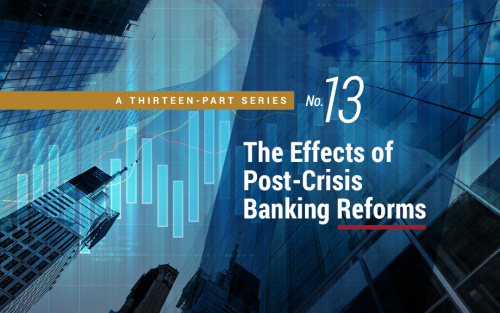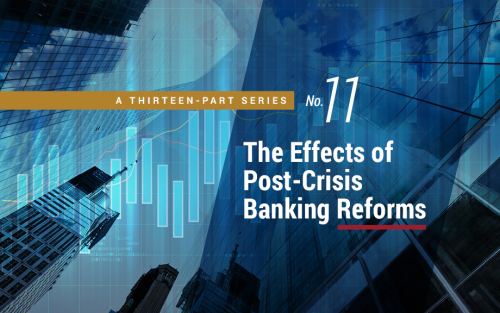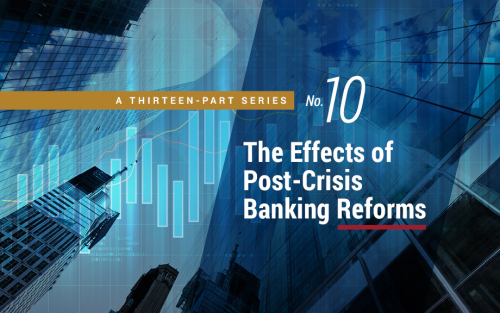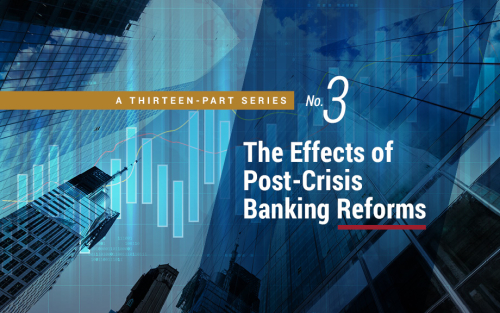Coming to Terms with Operational Risk

The term “operational risk” often evokes images of catastrophic events like hurricanes and earthquakes. For financial institutions, however, operational risk has a broader scope, encompassing losses related to fraud, rogue trading, product misrepresentation, computer and system failures, and cyberattacks, among other things. In this blog post, we discuss how operational risk has come into greater focus over the past two decades—to the point that it now accounts for more than a quarter of financial institutions’ regulatory capital.
Ten Years after the Crisis, Is the Banking System Safer?

In the wake of the 2007-09 financial crisis, a wide range of new regulations have been introduced to improve the stability of the banking system. But has the banking system become safer since the crisis? In this post, we provide a new perspective on this question by employing four analytical models, each measuring a different aspect of banking system vulnerability, to evaluate how system stability has evolved over the past decade.
Bank‑Intermediated Arbitrage

Since the 2007-09 financial crisis, the prices of closely related assets have shown persistent deviations—so-called basis spreads. Because such disparities create apparent profit opportunities, the question arises of why they are not arbitraged away. In a recent Staff Report, we argue that post-crisis changes to regulation and market structure have increased the costs to banks of participating in spread-narrowing trades, creating limits to a¬rbitrage. In addition, although one might expect hedge funds to act as arbitrageurs, we find evidence that post-crisis regulation affects not only the targeted banks but also spills over to less regulated firms that rely on bank intermediation for their arbitrage strategies.
Credit Market Choice

Credit default swaps (CDS) are frequently credited with being the cause of AIG’s collapse during the financial crisis. A Reuters article from September 2008, for example, notes “[w]hen you hear that the collapse of AIG […] might lead to a systemic collapse of the global financial system, the feared culprit is, largely, that once-obscure […] instrument known as a credit default swap.” Yet, despite the prominent role that CDS played during the financial crisis, little is known about how individual financial institutions utilize CDS contracts on individual companies. In a recent New York Fed staff report, we assess the choice banks face when trading the idiosyncratic credit risk of a firm, and argue that banks’ participation decisions have been affected in the post-regulation period, either by direct changes in market structure or by changes in the relative cost of pursuing different strategies.
Liquidity Effects of Post‑Crisis Regulatory Reform

The post-crisis regulatory reform efforts to improve capital and liquidity positions of regulated institutions provide incentives for banks to change not only the structure of their own balance sheets but also how they interact with their customers and other market participants more generally. A 2015 PwC study on global financial market liquidity, for example, noted that “[a]s banks respond to the new regulatory environment, they have sought to make more efficient use of capital and liquidity resources, by reducing the markets they serve and streamlining their operations.” In this blog post, we provide an overview of three recent New York Fed staff reports that study the impact that post-crisis regulation has had on the willingness and ability of regulated firms to participate in U.S. over-the-counter (OTC) markets.
Did Banks Subject to LCR Reduce Liquidity Creation?

Banks traditionally provide loans that are funded mostly by deposits and thereby create liquidity, which benefits the economy. However, since the loans are typically long-term and illiquid, whereas the deposits are short-term and liquid, this creation of liquidity entails risk for the bank because of the possibility that depositors may “run” (that is, withdraw their deposits on short notice). To mitigate this risk, regulators implemented the liquidity coverage ratio (LCR) following the financial crisis of 2007-08, mandating banks to hold a buffer of liquid assets. A side effect of the regulation, however, is a reduction in liquidity creation by banks subject to LCR, as we find in our recent paper.
Leverage Rule Arbitrage

Classic arbitrage involves the same asset selling at different prices; the leverage rule arbitrage we study here involves assets of different risk levels requiring the same amount of capital. The supplementary leverage ratio (SLR) rule, finalized by U.S. regulators in September 2014, requires a minimum ratio of capital to assets at the largest U.S. banks. The floor is higher for more systemically important banks, but not for banks with riskier assets. That non-risk-based aspect of SLR was intentional, since the leverage limit was meant to backstop (“supplement”) risk-based capital rules in case banks underestimate their asset risk and overstate their capital strength. As policymakers have noted and bankers have warned, if the leverage rule is the binding capital requirement, banks can “arbitrage” the rule by selling safer assets and replacing them with riskier, higher-yielding ones. The findings of our recent staff report are consistent with those concerns.
Resolving “Too Big to Fail”

Many market participants believe that large financial institutions enjoy an implicit guarantee that the government will step in to rescue them from potential failure. These “Too Big to Fail” (TBTF) issues became particularly salient during the 2008 crisis. From the government’s perspective, rescuing these financial institutions can be important to avoid harm to the financial system. The bailouts also artificially lower the risk borne by investors and the financing costs of big banks. The Dodd-Frank Act attempts to remove the incentive for governments to bail out banks in the first place by mandating that each large bank file a “living will” that details its strategy for a rapid and orderly resolution in the event of material distress or failure without disrupting the broader economy. In our recent New York Fed staff report, we look at whether living wills are effective at reducing the cost of implicit TBTF bailout subsidies.
Do You Know How Your Treasury Trades Are Cleared and Settled?

The Treasury Market Practices Group (TMPG) recently released a consultative white paper on clearing and settlement processes for secondary market trades of U.S. Treasury securities. The paper describes in detail the many ways Treasury trades are cleared and settledinformation that may not be readily available to all market participantsand identifies potential risk and resiliency issues. The work is designed to facilitate discussion as to whether current practices have room for improvement. In this post, we summarize the current state of clearing and settlement for secondary market Treasury trades and highlight some of the risks described in the white paper.
Have the Biggest U.S. Banks Become Less Complex?

The global financial crisis, and the ensuing Dodd-Frank Act, identified size and complexity as determinants of banks’ systemic importance, increasing the potential risks to financial stability. While it’s known that big banks haven’t shrunk, the question that remains is: have they simplified? In this post, we show that while the largest U.S. bank holding companies (BHCs) have somewhat simplified their organizational structures, they remain very complex. The industries spanned by entities within the BHCs have shifted more than they have declined, and the countries in which some large BHCs have entities still include numerous “secrecy” or tax-haven locations.










 RSS Feed
RSS Feed Follow Liberty Street Economics
Follow Liberty Street Economics